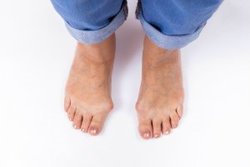If you haven’t already heard – your bunion wasn’t caused by women’s footwear. (There might be some male readers who have a bunion and are really glad to hear that!)
For many years, stylish pumps and stilettos took the blame for bunions. This made sense since A) women tend to get bunions more often than men, B) these shoes lead to excessive pressure on the front of the feet, and C) they usually have pointy toes that squish toes together.
The truth of the matter, though, is that footwear can contribute to a bunion, but doesn’t actually cause one. So with that being the case, why do you have a bunion?
Today, let’s address some of the mystery centered on why bunions actually develop – which hopefully will make the situation a little less uncertain for you.
Your metatarsal bones are the five long bones in each one of your feet. These bones run lengthwise from the midfoot to the toes, where they meet bones known as your phalanges. Accordingly, the joints where your foot and toe bones connect are called metatarsophalangeal (MTP) joints, and this is important to know when we talk about bunions.
A bunion develops at the MTP joint for the big toe. In this condition, the joint is pushed out to the side, which explains the abnormal bump on the inner edge of your foot. This can be attributed to an uneven distribution of pressure—and not simply to women’s shoes—created by factors that can include inherited foot structure and irregular biomechanics.
Instability in the joint and its supporting tendons enable the big toe to start drifting inwards. In severe cases, the big toe starts to overlap the second (crossing either over or under the normally-positioned toe).
As noted, increased risk for this condition is often a matter of genetics and foot structure. Abnormal biomechanics from a problematic foot type—particularly a flatfoot condition—can lead to the pressure necessary to create a bunion. Foot injuries, congenital deformities, and neuromuscular disorders are other potential root causes. Additionally, foot or ankle arthritis pain can force someone to alter the way he or she walks, thereby making it more likely for that person to develop a bunion.
It isn’t uncommon to wonder if kids can get bunions, given the frequent association between bunions and women’s footwear, but it is certainly possible for children to develop them. Early intervention and treatment are best in these cases (so as to prevent bigger problems later down the road).
When it comes to treating bunions, there are conservative measures we use to see if they sufficiently help with the problem. Surgery can be the best option for certain cases, but this is something we will discuss together.
For more information on bunions, or to request an appointment to have one treated, contact Martin Foot and Ankle by calling (717) 757-3537.
